This article was co-authored by wikiHow staff writer, Kyle Hall. Kyle Hall works on the content team at wikiHow. He helps manage our team of editors and creates content for a variety of wikiHow projects. Kyle continually looks for new ways to improve the content at wikiHow and make it more helpful and enjoyable for readers. He graduated from Eckerd College in 2015, where he majored in Political Science.
There are 16 references cited in this article, which can be found at the bottom of the page.
The wikiHow Video Team also followed the article's instructions and verified that they work.
This article has been viewed 115,361 times.
Learn more...
Mice are cute, furry foragers that are known for their round ears and long, skinny tails. You can easily make an adorable origami mouse, whether you’re a beginner or looking to add to your origami animal kingdom (along with an origami wolf, turtle, and butterfly, perhaps). All you need to get started is a square piece of paper and a flat surface to work on!
Steps
Making the Mouse’s Body
-
1Get a square piece of paper to make your origami mouse with. Any kind of thin paper will work, although paper designed specifically for origami may be easier to work with. If you don’t have square paper, use scissors to cut regular paper into a square.[1]
- You can use any color of paper to make your origami mouse with. If you want a realistic-looking mouse, go with a brown, black, or white piece of paper. If you want something that’s more whimsical and fun, try brightly-colored paper or paper with a pattern on it.
-
2Fold the paper in half diagonally both ways and then unfold. Crease the paper with your fingers after each fold. When you’re finished, you should have 2 long creases that intersect in the middle of the paper.[2]
- Orient the paper so it looks like a diamond after you make your 2 folds.
Advertisement -
3Fold the bottom left and right edges up to the vertical crease and unfold. Try to make the edges line up with the crease as much as possible so there’s no gap between them. Also, be careful not to overlap the edges at the crease or you may have some problems folding your origami mouse later on.[3]
- Don’t forget to crease and unfold the edges after you fold them.
-
4Repeat with the top left and right edges of the paper but don’t unfold. Just like you did with the bottom edges, fold the top left and right edges to the vertical crease. This time, however, don’t unfold the edges. Crease along the folds with your fingers and then leave the edges folded down.[4]
- When you’re finished, the paper should be folded in a kite shape.
-
5Lift the flaps and fold the corners over to the vertical crease. After you lift up the flaps that you made with your previous fold, take the left and right corners of the paper and push them toward the center crease. Then, flatten along the existing creases so you have 2 new, smaller flaps sticking up on the model.[5]
- Push the new, smaller flaps down so they’re lying flat.
- The new flaps should naturally form along the existing creases that you made with your previous folds.
-
6Fold one of the flaps down and fold the bottom edge up to the top edge. Start by folding one of the small flaps down toward the bottom of the model and creasing along the horizontal fold. Then, bring the bottom, diagonal edge up to the horizontal crease you just made. Finally, crease along the new fold.[6]
- When you’re finished, bring the folded flap up and behind the other flap so it’s not in your way.
-
7Repeat with the other flap. Fold the flap down and crease along the horizontal line. Then, bring the bottom edge up to the horizontal fold you just made and crease the new fold.[7]
- Bring the folded flap up so it’s next to the other folded flap.
-
8Flip the model over and fold the bottom point up above the horizontal crease. This fold doesn’t need to be precise—it doesn’t matter how far above the horizontal crease you fold the bottom point, as long as it’s above it. However, try to position the point so it’s about halfway between the top point on the model and the horizontal crease.[8]
- Remember to crease along the fold with your fingers.
-
9Fold up both bottom corners. You want to fold the corners up toward the horizontal crease, but not all the way. Instead, stop when the folds make a straight, diagonal line between the ends of the horizontal crease and the bottom, middle point of the model.[9]
Folding the Ears
-
1Turn the model over and mountain fold it in half lengthwise. A mountain fold is a fold that’s done away from yourself so that the crease looks like the peak of a mountain (as opposed to a valley fold, which would be done toward yourself and look like a valley). The model should easily fold in half lengthwise along the vertical crease you made earlier.[10]
- After you mountain fold the model in half lengthwise, lay it flat so you’re only looking at one side.
- At this point, you should be able to see the beginning of your mouse’s ears and nose.
-
2Fold the flap over and then bring the corner back to make an ear. First, fold the flap over so that it’s lying flat on the shorter half of the model (the half that will eventually become your mouse’s face and nose). Then, take the corner and fold it down and back so the edge is perpendicular with the top, horizontal edge of the model.[11]
- Crease the fold so the ear stays in place.
-
3Flip the model over and repeat with the other flap. Make sure the flap is lying flat on the shorter half of the model. Then, fold it down and back and crease along the fold.[12]
- Now your mouse should have 2 ears!
-
4Insert a finger into the ear flaps to make them round and 3-dimensional. The edge of each ear should have an opening that you can easily stick a finger into. Once your finger is inside, use another finger to press on the outer crease to round it out and give the ears some shape.[13]
- Don’t worry about making the ears perfect. You can always go back in later and round them out some more.
Making the Tail
-
1Fold the long half of the model in on itself to start the tail. First, use your fingers to press down on the top, horizontal edge of the model so the long half of the model is flat. Then, continue pressing the edge of the model down while pressing the sides of the model inward. Keep pressing until you’ve folded the long half in on itself and the end is pointing downward.[14]
- Crease the diagonal fold along the top edge of the model.
-
2Bring the end of the tail up and push it inside of the fold you just made. Flatten the end of the tail and push it upward with your fingers so it goes inside of the diagonal fold. Once the end of the tail is pointing upward, crease the diagonal fold again to secure the tail inside of it.[15]
- The angle of the tail doesn’t need to be precise. The tail just needs to be pointing up and be tucked inside of the diagonal fold.
-
3Open the tail up and fold the corners in to make it thinner. Once the tail is open, take each corner and fold it toward the center crease inside of the tail. This fold doesn’t need to be precise, but the closer you fold the corners to the center crease, the thinner your mouse’s tail will be.[16]
- After you fold the corners inside of the tail, crease the folds and then close the tail.
- Once you're done folding the tail, your origami mouse is finished!
Community Q&A
-
QuestionHow do I fold so it does not open?
 Community AnswerUse a lot of pressure when making the creases to keep the folds in place and it should work. Otherwise, use tape.
Community AnswerUse a lot of pressure when making the creases to keep the folds in place and it should work. Otherwise, use tape. -
QuestionHow big/small does the square paper have to be?
 Community AnswerIt doesn't matter, as long as it is a square piece of paper with straight lines and equal sides.
Community AnswerIt doesn't matter, as long as it is a square piece of paper with straight lines and equal sides.
Things You’ll Need
- Square piece of paper
- Pen or pencil (optional)
References
- ↑ https://www.redtedart.com/origami-mice-a-cute-paper-mouse-craft/
- ↑ https://www.youtube.com/watch?v=Kut1LLUT6-s&feature=youtu.be&t=33
- ↑ https://www.youtube.com/watch?v=Kut1LLUT6-s&feature=youtu.be&t=73
- ↑ https://www.youtube.com/watch?v=Kut1LLUT6-s&feature=youtu.be&t=104
- ↑ https://www.youtube.com/watch?v=Kut1LLUT6-s&feature=youtu.be&t=134
- ↑ https://www.youtube.com/watch?v=Kut1LLUT6-s&feature=youtu.be&t=163
- ↑ https://www.youtube.com/watch?v=Kut1LLUT6-s&feature=youtu.be&t=182
- ↑ https://www.youtube.com/watch?v=Kut1LLUT6-s&feature=youtu.be&t=198
- ↑ https://www.youtube.com/watch?v=Kut1LLUT6-s&feature=youtu.be&t=218
- ↑ https://www.youtube.com/watch?v=Kut1LLUT6-s&feature=youtu.be&t=242
- ↑ https://www.youtube.com/watch?v=Kut1LLUT6-s&feature=youtu.be&t=254
- ↑ https://www.youtube.com/watch?v=Kut1LLUT6-s&feature=youtu.be&t=272
- ↑ https://www.youtube.com/watch?v=Kut1LLUT6-s&feature=youtu.be&t=287
- ↑ https://www.youtube.com/watch?v=Kut1LLUT6-s&feature=youtu.be&t=321
- ↑ https://www.youtube.com/watch?v=Kut1LLUT6-s&feature=youtu.be&t=344
- ↑ https://www.youtube.com/watch?v=Kut1LLUT6-s&feature=youtu.be&t=373
About This Article
To make an origami mouse, first fold a square piece of paper in half diagonally both ways and unfold it. Then, fold the bottom left edge up to the vertical center crease. Repeat with the bottom right edge, then unfold both edges. Now, do the same thing with the top left and right edges, but don’t unfold them. Lift up one of the flaps and fold the corner over to the vertical crease along the existing creases. Repeat with the other flap so you have two new smaller flaps. Next, fold one of the flaps down and bring the diagonal edge up to the horizontal crease in the center. Do the same thing with the other flap. Flip the model over, and fold the bottom point up so it’s halfway between the horizontal crease and the top point. Then, fold up the bottom corners so the folds make a straight, diagonal line between the ends of the horizontal line and the bottom point on the model. To make your mouse’s ears, turn the model over and mountain fold it in half lengthwise. Next, take the flap on top and fold it over and then back. Turn the model over and repeat with the flap on the other side. Stick your finger into the ear flaps to make them round. To make your mouse’s tail, fold the long half of the model in on itself so the end is pointing downward. Then, bring the end of the tail up and push it inside of that fold. Finally, open the tail and fold the corners in so that it’s thinner.
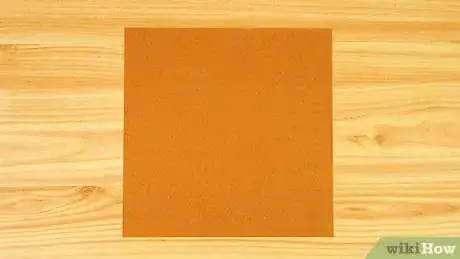
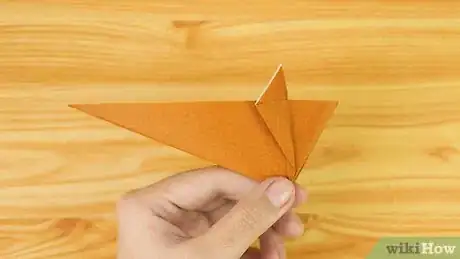
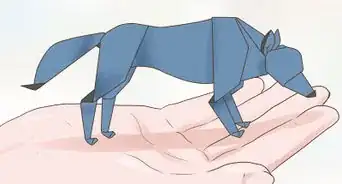











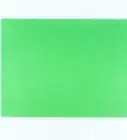
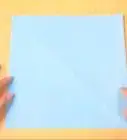
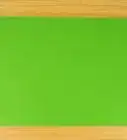
-Step-19-Version-4.webp)


































